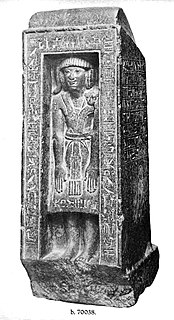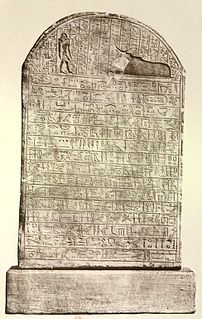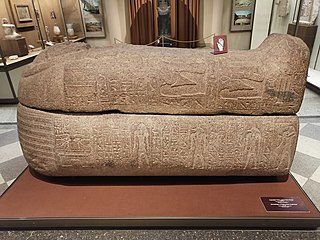Related Research Articles

Merneferre Ay was an ancient Egyptian pharaoh of the mid 13th Dynasty. The longest reigning pharaoh of the 13th Dynasty, he ruled a likely fragmented Egypt for over 23 years in the early to mid 17th century BC. A pyramidion bearing his name shows that he possibly completed a pyramid, probably located in the necropolis of Memphis.

Memphis was the ancient capital of Inebu-hedj, the first nome of Lower Egypt. Its ruins are located near the town of Mit Rahina, 20 km (12 mi) south of Giza in Greater Cairo, Egypt.

Ptah is an ancient Egyptian deity, the god of craftsmen and architects. In the triad of Memphis, he is the husband of Sekhmet and the father of Nefertem. He was also regarded as the father of the sage Imhotep.

In ancient Egyptian religion, Apis or Hapis, alternatively spelled Hapi-ankh, was a sacred bull worshiped in the Memphis region, identified as the son of Hathor, a primary deity in the pantheon of ancient Egypt. Initially, he was assigned a significant role in her worship, being sacrificed and reborn. Later, Apis also served as an intermediary between humans and other powerful deities.
The djed is one of the more ancient and commonly found symbols in ancient Egyptian religion. It is a pillar-like symbol in Egyptian hieroglyphs representing stability. It is associated with the creator god Ptah and Osiris, the Egyptian god of the afterlife, the underworld, and the dead. It is commonly understood to represent his spine.
Prince Khaemweset was the fourth son of Ramesses II, who was born c. 1303 BCE; died July or August 1213 BCE; reigned 1279–1213 BCE, and the second son by his queen Isetnofret. He is by far the best known son of Ramesses II, and his contributions to Egyptian society were remembered for centuries after his death. Khaemweset has been described as "the first Egyptologist" due to his efforts in identifying and restoring historic buildings, tombs and temples.

King Usermaatre Setepenre/SetepenamunShoshenq III of the 22nd Dynasty ruled for 39 years according to contemporary historical records. Two Apis Bulls were buried in the fourth and 28th years of his reign and he celebrated his Heb Sed Jubilee in his regnal year 30. Little is known of the precise basis for his successful claim to the throne since he was not a son of Osorkon II and Shoshenq's parentage and family ties are unknown.

Neterkheperre or Netjerkheperre-Setepenamun Siamun was the sixth pharaoh of Egypt during the Twenty-first Dynasty. He built extensively in Lower Egypt for a king of the Third Intermediate Period and is regarded as one of the most powerful rulers of the Twenty-first Dynasty after Psusennes I. Siamun's prenomen, Netjerkheperre-Setepenamun, means "Divine is The Manifestation of Ra, Chosen of Amun" while his name means 'son of Amun.'
Pipi or Pipis may refer to:

Thutmose was the eldest son of Pharaoh Amenhotep III and Queen Tiye, who lived during the Eighteenth Dynasty of Egypt. His early death led to the reign of Akhenaten, his younger brother—as the successor to the Egyptian throne—and the intrigues of the century leading up to Ramesses II, the start and ultimately the failure of Atenism, the Amarna letters, and the changing roles of the kingdom's powers.

The High Priest of Ptah was sometimes referred to as "The Greatest of the Directors of Craftsmanship" (wr-ḫrp-ḥmwt). This title refers to Ptah as the patron god of the craftsmen.

Ptahmose was High Priest of Ptah in Memphis during the time of Thutmose III of the 18th Dynasty.
Ptahmose was High Priest of Ptah in Memphis during the time of Thutmose IV and in the beginning of the reign of Amenhotep III.

Ptahmose was High Priest of Ptah in Memphis during the time of Thutmose IV and/or Amenhotep III. He was the son of a Prophet (priest) named Menkheper. Ptahmose's son Pahonte would later serve as High Priest of Ptah.
Ashakhet II was a High Priest of Ptah during the 21st Dynasty. He served during the reigns of Siamun and Psusennes II.

Sehetepebreankh-nedjem was an ancient Egyptian official with the titles royal sealer, foremost of action, Sem-priest and Great one of the leaders of craftsmen. The latter title is that of the High Priest of Ptah. The god Ptah was the deity of arts and crafts and therefore, the high priest of Ptah had a title related to crafts. Sehetepebreankh-nedjem is known from a group statue showing him, his son and his grandson. The statue was dedicated by his son Nebpu, who was also High Priest of Ptah. The statue is datable by style to the end of the Twelfth Dynasty and is now in the Louvre. The statue was bought in 1816 by the Louvre and is most likely from Memphis. This city was the major cult centre for Ptah.

The ancient Egyptian noble Prehotep II was Vizier in the latter part of the reign of Ramesses II, during the 19th Dynasty.
Articles related to ancient Egypt include:

The Stela of Pasenhor, also known as Stela of Harpeson in older literature, is an ancient Egyptian limestone stela dating back to the Year 37 of pharaoh Shoshenq V of the 22nd Dynasty. It was found in the Serapeum of Saqqara by Auguste Mariette and later moved to The Louvre, where it is still.

Nakhy was an Ancient Egyptian priest in the function of a High Priest of Ptah, who lived most likely in the 19th Dynasty.
References
- ↑ Berta Porter, Rosalind L. B. Mossː Topographical Bibliography of Ancient Egyptian Hieroglyphic Texts, Reliefs, and Paintings, III (2). Memphis (second edition) Oxford 1981, p. 706 online
- ↑ B. Pörtner, A. Wiedemannː Aegyptische Grabreliefs aus der Grossherzoglichen Altertümer-Sammlung zu Karlsruhe, Strassburg 1906, p. 32, pl. VII
- ↑ André Jolles: Die ägyptisch-mykenischen Prunkgefässe, in: Jahrbuch des Deutschen Archäologischen Instituts, 23 (1908). p. 249, fig. 50 online